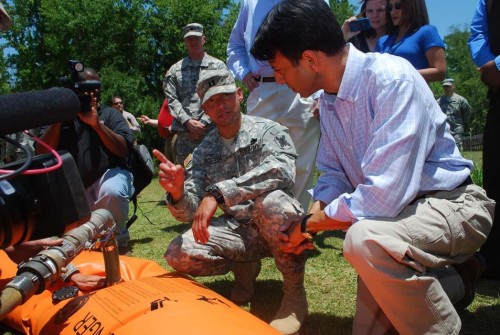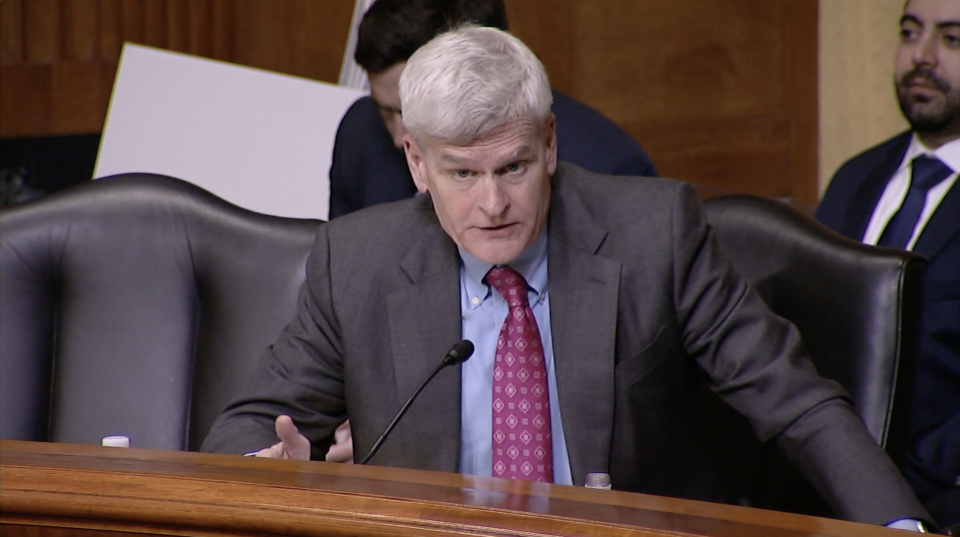
Leo Cavell
May 24, 2011
James Walker
May 26, 2011The U.S. National Guard briefed Gov. Bobby Jindal on the Terrebonne Tiger Dam Bayou Black Project last Wednesday, outlining a cooperative effort between local government leaders and the area’s residents to curtail the potential of a flood disaster.
As of Monday, more than 15,500 feet of the water-inflatable Tiger Dams are filled and in place, according to the state.
The project is expected to help the Gibson-Bayou Black area, but it also aims to alleviate flood concerns for approximately 4,500 people and 2,500 structures, Jindal said.
“These structures will help protect from flooding not only here, but in surrounding communities as well,” he explained.
The governor said the original U.S. Army Corps of Engineers projections, which he described as a worst-case scenario, had changed almost 110 hours after the first bay of the Morganza Spillway was opened.
Gibson and Bayou Black can expect 3 to 4 feet of water, Jindal said. He said the western Terrebonne crest date would be approximately three days after the water crests in Morgan City, which is projected as May 29.
The governor attributed the change in forecast to a slower-than-expected flow, facilitated by less Morganza bay openings and favorable weather conditions.
Whereas the spillway was once expected to divert water at 300,000 cubic feet per second from the Mississippi River to the Atchafalaya, the governor said the corps is basing its new projections on a diversion of 125,000 cfs.
Jindal cautioned residents from putting too much stock into the projections and warned against complacency.
“These are all projections and models,” he said. “This is all based on [the corps’] best estimates. They can’t really model the impacts of the drought that’s absorbing a lot of the water. They can’t model the impact of new crawfish ponds and other things that have been done since ’73.
“There is a historic amount of water coming our way. We all hope that the worst-case scenarios don’t come true, but even in the best-case scenarios, there is an awful lot of water coming through the spillway, there is going to be an awful lot of water coming through these tributaries.”
Terrebonne Parish President Michel Claudet said he does not anticipate the parish issuing an evacuation order as of Wednesday, but didn’t rule out a future possibility. He said the parish would continue to monitor the elevation levels and deploy sandbags.
More than 200,000 sandbags have been given to parish residents, he said.
The Mississippi River is cresting at record levels after heavy precipitation last winter. The Morganza Spillway was opened last Saturday when the river’s flow rate reached 1.5 million cfs at the Red River Landing measuring point, which diverted some of the volume into the rural Atchafalaya Basin in a strategy to protect Baton Rouge and New Orleans from flooding.
The governor spoke to the media in front of a home on Bayou Black Drive, which will be protected by the Tiger Dams. The governor was briefed on the usage of the dams as they were filled by local fire departments and spoke with people from the area.
The Tiger Dams, 18 inches high, 50 feet long and connectable, have been laid out to protect Bayou Black Elementary and Greenwood Middle schools and several residences along a 2-mile stretch of Bayou Black Drive.
Sue Wunstell said she felt “a little better” after watching the governor address the media. Wunstell’s home in Gibson sits 5 feet above sea level and will be surrounded by Tiger Dams.
“We’ve never had help before,” she said. “Whereas this time, we do have some kind of response and help from the federal government.”
Wunstell said a 1991 flood, caused by rain, was the most water she’s have had on her property. It seeped into her backyard shed, but did not reach her house.
The Wunstells do not have a flood insurance policy, but Sue said she was not concerned as much with water getting into her house as the problems that would come with 3 to 4 feet of standing water in her yard.
“If the water does come up and stays a while, I’m concerned about bacteria and how to use your facilities,” she said. “You won’t be able to flush your toilets, take baths or all this running water. What do you do then? Really, you can’t stay in your homes with those conditions.”
The family is still considering where it would go in case of an evacuation.
Terrebonne Councilwoman Arlanda Williams said the support from her fellow councilmen, one of whom pledged to remove projects from the parish budget to create additional funds, if necessary, has relieved some of her initial panic.
She equated the outpouring of support from her peers and parish officials to the “Dream Team,” and said she is very appreciative of their assisting her constituents.
“I don’t know every person in this district, but I do know that I have some strong ties down here and I want to make sure that these families are able to stay together.”
Williams said that as the crest date approaches, the parish would continue to monitor elevation levels and keep filling sandbags. If the elevation projections rise, extra layers of Tiger Dams may be utilized.
Also, corps officials and the area’s families haven’t been able to strike middle ground on where a potential drainage levee should be placed, and that’s something Williams said needs to be worked out in anticipation of the approaching floodwaters.
Gov. Bobby Jindal gets an update from Capt. Nicholas Acosta of the Louisiana National Guard on the Tiger Dams, 50-foot long water-inflatable tubes which should act as a deterrent to expected spring-melted floodwaters. ERIC BESSON











